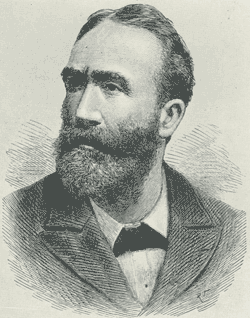John O'Connor, Landscape and Scene-Painter
(b. 1830, d. 1889)
Landscape and Scene-Painter
From A Dictionary of Irish Artists 1913

John O'Connor, A.R.H.A. Woodcut in "Illustrated London News."
Was born in the county of Derry on 12th August, 1830, the third son of Francis O'Connor and his wife, Rose Cunningham of Bath. Left an orphan at the age of 12, he had to earn his own livelihood, and, as his parents had been connected with the stage and his mother's brother was lessee of the Belfast and Liverpool theatres, he began as a call-boy at the Belfast theatre and as an assistant in scene-painting. For a short time he worked in the Dublin theatre, and in 1845 joined a travelling company as scene-painter. In 1848, having become proficient in his art, he went to London and found employment at Drury Lane, and later at the Haymarket theatre. With this theatre he was connected for many years, and became principal scene-painter in 1863. He had few equals in his art, and excelled in architectural designs and as a colourist. He was especially renowned for his drop-scenes, among the most notable being that at the Manchester theatre, a "View of Windsor Castle"; the "Minuet" at the Haymarket, and others at Sadler's Wells and the St. James' theatres. In 1849 he was in Ireland and painted a "Diorama of the Queen's Visit," which was exhibited at the Chinese Gallery in London.
While still pursuing his calling as a scene-painter he took up landscape painting both in oil and water-colour, and in this field of art, especially in his numerous architectural drawings, he attained some distinction. He began to exhibit at the Society of British Artists in 1854, and at the Royal Academy in 1857, and was a frequent contributor down to 1888, his work including views in London, and in Italy, France and Spain—the results of many visits to the Continent begun in 1855. He also exhibited at the new Water-colour Society, of which he became a Member in 1887; and he contributed some of his most important works to the Royal Hibernian Academy from 1875 onwards. He was elected an Associate on the 18th October, 1883. In 1870 and 1871 he visited France during the Franco-German war. He was accompanied by Lord Ronald Gower, and in 1872 they took a studio together in Leicester Square, in Sir Joshua Reynolds' old house, which became the meeting-place of many men of note in the artistic and dramatic word. In 1878 he resigned his appointment at the Haymarket theatre.
O'Connor was one of the most popular men in his profession. He was a favourite with the Royal Family, and did drawings of many important Court ceremonials, such as the Marriage of the Princess Louise in 1871, the Thanksgiving Service in St. Paul's in 1872, the Arrival of the Duke and Duchess of Edinburgh at Buckingham Palace, 1874, and the Jubilee Service in Westminster Abbey in 1887. He decorated a room for the Duke of Westminster at Eaton with large paintings in oil, and another with drawings; and designed and executed many of the tableaux vivants held at Cromwell House. In 1864 he painted the scenery for the Shakespeare tercentenary performances at Stratford, and also did some beautiful work for the Greek plays at Cambridge. Shortly before his death he visited India to see his two younger sons, and on his return he settled at Heathcroft, Yateley, Hampshire, where on the 23rd May, 1889, he died of paralysis. He was buried in Finchley cemetery. O'Connor was a man of genial and taking manners, which secured him many friends and made him popular with everyone.
In the National Gallery of Ireland is a drawing, "Old York Gate," done in 1861, exhibited at the Royal Academy in 1872 and presented to the Gallery by the artist. His "Market Place, Verona," exhibited in 1881, is in the Walker Art Gallery, Liverpool; and three drawings are in the British Museum: "The Borghese Fountain," "Study of Aloes," and "St. Paul's from Waterloo Bridge."
« James Arthur O'Connor | Contents and Search | Joseph O'Connor »
